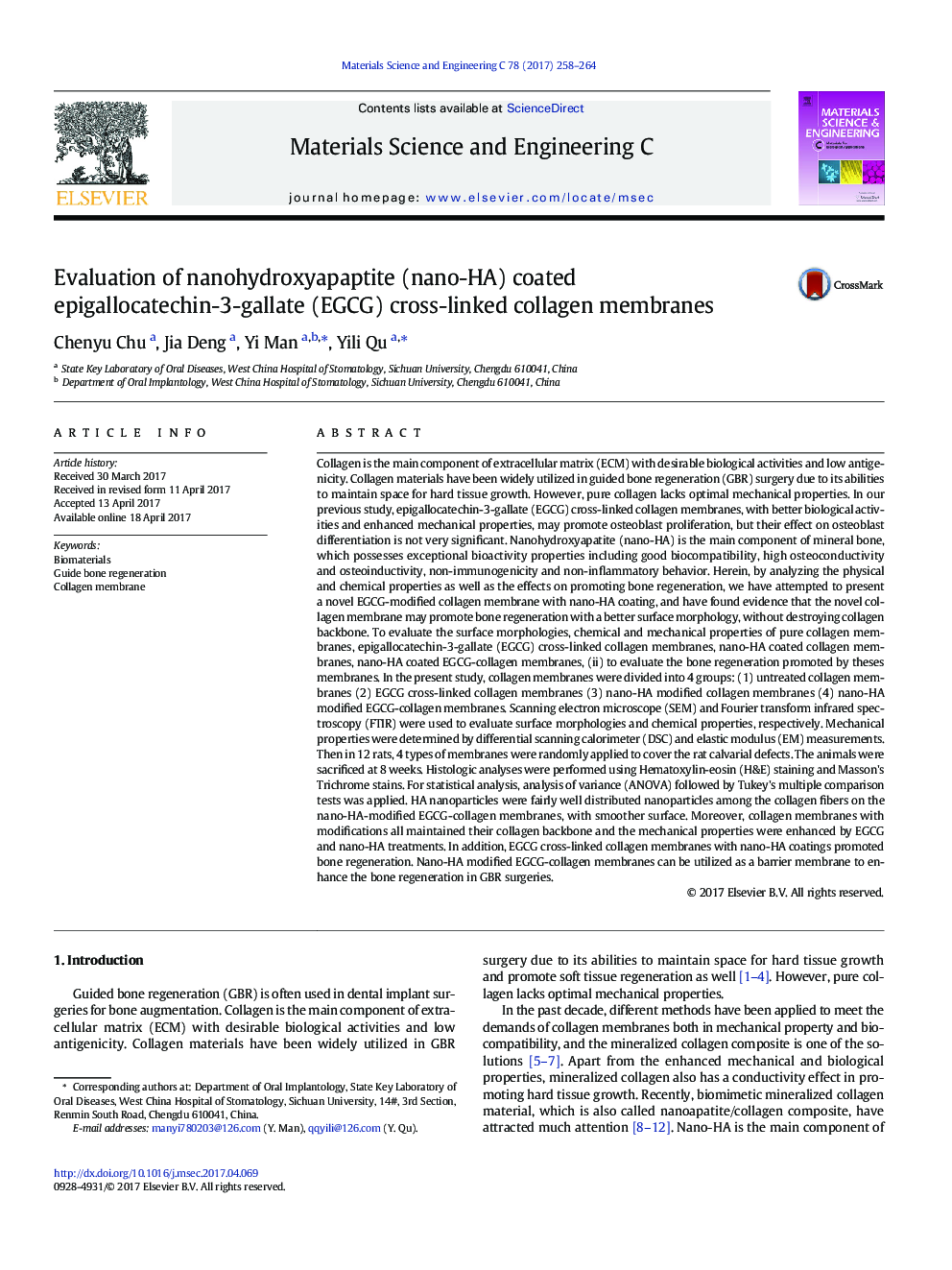| کد مقاله | کد نشریه | سال انتشار | مقاله انگلیسی | نسخه تمام متن |
|---|---|---|---|---|
| 5434413 | 1509143 | 2017 | 7 صفحه PDF | دانلود رایگان |

- Nano-HA coated EGCG-collagen membranes promote bone regeneration.
- Structure characteristics of collagen were maintained after addition of EGCG and nano-HA.
- Mechanical properties were changed after addition of EGCG and nano-HA.
Collagen is the main component of extracellular matrix (ECM) with desirable biological activities and low antigenicity. Collagen materials have been widely utilized in guided bone regeneration (GBR) surgery due to its abilities to maintain space for hard tissue growth. However, pure collagen lacks optimal mechanical properties. In our previous study, epigallocatechin-3-gallate (EGCG) cross-linked collagen membranes, with better biological activities and enhanced mechanical properties, may promote osteoblast proliferation, but their effect on osteoblast differentiation is not very significant. Nanohydroxyapatite (nano-HA) is the main component of mineral bone, which possesses exceptional bioactivity properties including good biocompatibility, high osteoconductivity and osteoinductivity, non-immunogenicity and non-inflammatory behavior. Herein, by analyzing the physical and chemical properties as well as the effects on promoting bone regeneration, we have attempted to present a novel EGCG-modified collagen membrane with nano-HA coating, and have found evidence that the novel collagen membrane may promote bone regeneration with a better surface morphology, without destroying collagen backbone. To evaluate the surface morphologies, chemical and mechanical properties of pure collagen membranes, epigallocatechin-3-gallate (EGCG) cross-linked collagen membranes, nano-HA coated collagen membranes, nano-HA coated EGCG-collagen membranes, (ii) to evaluate the bone regeneration promoted by theses membranes. In the present study, collagen membranes were divided into 4 groups: (1) untreated collagen membranes (2) EGCG cross-linked collagen membranes (3) nano-HA modified collagen membranes (4) nano-HA modified EGCG-collagen membranes. Scanning electron microscope (SEM) and Fourier transform infrared spectroscopy (FTIR) were used to evaluate surface morphologies and chemical properties, respectively. Mechanical properties were determined by differential scanning calorimeter (DSC) and elastic modulus (EM) measurements. Then in 12 rats, 4 types of membranes were randomly applied to cover the rat calvarial defects. The animals were sacrificed at 8Â weeks. Histologic analyses were performed using Hematoxylin-eosin (H&E) staining and Masson's Trichrome stains. For statistical analysis, analysis of variance (ANOVA) followed by Tukey's multiple comparison tests was applied. HA nanoparticles were fairly well distributed nanoparticles among the collagen fibers on the nano-HA-modified EGCG-collagen membranes, with smoother surface. Moreover, collagen membranes with modifications all maintained their collagen backbone and the mechanical properties were enhanced by EGCG and nano-HA treatments. In addition, EGCG cross-linked collagen membranes with nano-HA coatings promoted bone regeneration. Nano-HA modified EGCG-collagen membranes can be utilized as a barrier membrane to enhance the bone regeneration in GBR surgeries.
124
Journal: Materials Science and Engineering: C - Volume 78, 1 September 2017, Pages 258-264